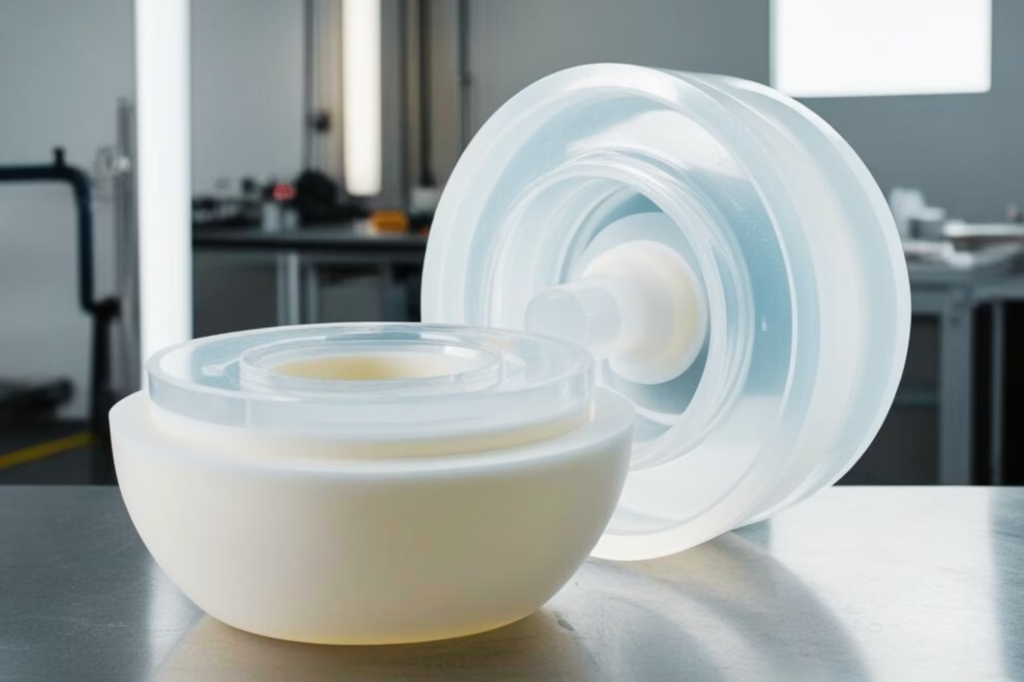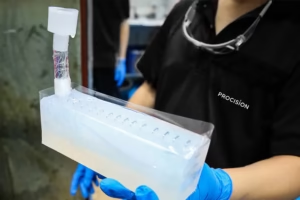Vacuum Casting-Production Quality, Fast
Get injection-molded look and feel, without injection-molded costs or delays.

- ISO 9001 & 13485
- No MOQ
- Full DFM Support
- Global Tech Team
How Vacuum Casting Compares to Other Short-Run Production Methods
For low volumes and show-ready surfaces, polyurethane casting beats 3D printing for finish surface quality and tops CNC machining for making complex shapes at a reasonable cost.
When volumes grow and geometry stabilizes, Plastic Injection Molding is the next step forward. We’re here to help you scale up to full production when you’re ready.
What Is Vacuum Casting?

Vacuum Casting, or named as polyurethane casting (PU casting) creates finished plastic parts that look and feel injection-molded, at a fraction of the lead time and tooling cost. Using a 3D-printed or machined master and an RTV silicone mold, we deliver short runs with crisp details, tight cosmetics, and consistent fit.
It’s an ideal solution for design validation, demo-ready models, bridge-to-tooling pilots, and small-batch production.
- Fast: Typical lead time 7–14 days
- Low risk: Silicone molds, 20–25 shots per mold
- High finish: Textures, gloss, tints, and over mold effects
Cost-effective: Production-like parts without production tooling’
Why Choose Procision for Vacuum Casting Services?
When you partner with us for vacuum casting services, you’ll receive exactly the results you expect.
Vacuum Casting vs. CNC
Exceptional Quality and Speed
RTV Silicone molds can be made in as little as one week, while finished parts typically take a few more days. To get quality results it’s most important to invest time upfront in the preparation of the master pattern, since even minor surface features will be transfered to the casting with high fidelity.
Smart Quoting and No Minimum Order Requirements
With no minimum order volume or dollar value, you can limit your financial exposure as you prepare to go to market. Our smart quotation system delivers a detailed cost breakdown within 24-48 hours of your request so there’s no guesswork, surprises, or hidden costs. Fast turnaround, no risk.
Design for Manufacturing (DFM) Support
We provide a comprehensive DFM review, including expert advice on the best resin to use for your application. Our experience helps you avoid casting product delays by pointing out overhangs, improper draft angles, or “locked” features that may be difficult to silicone mold successfully.
Industry-Leading Material Verification and Quality Assurance
ISO 9001: 2015 certification means careful process control, which includes incoming material verification to ensure full traceability to meet your regulatory and performance requirements. Start to finish, accountable and transparent for complete confidence.
Custom Color Mixing and Matching
Most standard colors can be pre-mixed with the resin so they’re permanently baked into the finished part. But if you have a special or custom color, we have a state-of-the-art painting facility where we can match any Pantone or RAL color you want, in any shade or hue, with matte, semi-gloss and high gloss production-quality results.
(Pantone®-Matched Vacuum Casting)
| Parameter | Specification | Notes |
|---|---|---|
| Color Standard | Pantone® C/U/TCX Series | Provide PMS code with order |
| MOQ | 500g (standard) / 1kg (custom mix) | Per production batch |
| Lead Time | +3 workdays | For color matching & verification |
| Material Impact | May affect cure time by ±5% | Requires process recalibration |
Polyurethane Vacuum Casting Materials
Match common plastics like ABS, PC, PP, PA/nylon, PMMA, and soft elastomers (Shore A-D). These analogue allow you to replicate the look and feel of most resin types used in consumer and industrial applications.
Many options are available to achieve heat resistance, UV stability, clarity, and glass-filled strength and rigidiity. Note however that pourable urethanes cannot achieve the same density as their injection molded counterparts.
In addition, overmolding lets you combine two or more urethanes together with different properties, so it’s perfect for grips, gaskets, and soft-touch features.” 5) These two sections need to be redesigned H2: Design Tips for Better Castings
- Wall thickness: ≥ 0.75 mm recommended. If any features are too thin they may not fill properly in the mold.
- Draft: 3-5° on vertical walls for clean demolding.
- Features: Ribs/fillets improve strength and fill; avoid knife-edges that are easy to damage in the silicone mold.
Master patterns: Can be made from any solid material, but they must be able to withstand prolonged heating at 40∞C without damage.
| Analogue | Material Name | Color | Density | Hardness | Mold Tool Life |
|---|---|---|---|---|---|
| ABS | UP 4280 | Off-White Light-Beige Black | 1.12 | Shore 80D | 15 - 20 Parts |
| HT ABS | PX 223-HT | Black | 1.14 | Shore 80D | 30 - 40 Parts |
| FR ABS | Hei-Cast 8263 | Milky White | 1.3 | Shore 80D | 15 - 20 Parts |
| PC/PMMA | UPX5210 | Transparent | 1.1 | Shore 83D | 10 - 15 Parts |
| PP | UP 5690 | White Black | 1.13 | Lower limit: 65D Upper limit: 83D Shore Hardness Tolerance : ± 5D | 15 - 20 Parts |
| Rubber | UPX 8400 | Off-White Black | 1.2 | Lower limit: 40A Upper limit: 85A Shore Hardness Tolerance : ± 5A | 20 - 30 Parts |
| ABS+GF | UP 4280+10%GF | Off-White Light-Beige Black | 1.12 | 15 - 20 Parts | |
| HT ABS+GF | PX 223-HT+10%GF | Black | 1.14 | 30 - 40 Parts | |
| PC/PMMA+GF | UPX5210+10%GF | Translucent | 1.1 | 10 - 15 Parts | |
| PP+GF | UP 5690+10%GF | White Black | 1.13 | 15 - 20 Parts | |
| Silicone | RTV-4260 | Translucent | 1.1 | Shore 42A | 20 - 30 Parts |
| ABS | VC-4280 | Off-White Black | 1.12 | Shore 81D | 15 - 20 Parts |
| Rubber | VC-8400 | Off-White Black | 1.2 | Lower limit: 40A Upper limit: 85A Shore Hardness Tolerance : ± 5A | 20 - 30 Parts |
| PP | VC-5690 | White Black | 1.13 | Lower limit: 65D Upper limit: 78D Shore Hardness Tolerance : ± 5D | 15 - 20 Parts |
| PC/PMMA | VC-521HT | Transparent | 01.06 | Shore 88D | 10 - 15 Parts |
| HT ABS | VC-223HT | Black | 1.14 | Shore 80D | 30 - 40 Parts |
| HT ABS | VC-6160 | Light amber | 1.2 | Shore 80D | 15 - 20 Parts |
| ABS\PC | VC-527 | White Black | 1.15 | Shore 80D | 18 - 20 Parts |
| PA/POM | VC-246 | White Black | 1.18 | Shore 85D | 15 - 20 Parts |
| FR ABS | VC-330 | White Black | 1.2 | Shore 82D | 15 - 20 Parts |
| ABS+GF | VC-4280+10%GF | Off-White Black | 1.12 | 15 - 20 Parts | |
| PP+GF | VC-5690+10%GF | White Black | 1.13 | 15 - 20 Parts | |
| PC/PMMA+GF | VC-521HT+10%GF | Transparent | 01.06 | 10 - 15 Parts | |
| HT ABS+GF | VC-223HT+10%GF | Black | 1.14 | 30 - 40 Parts | |
| HT ABS+GF | VC-6160+10%GF | Light amber | 1.2 | 15 - 20 Parts | |
| ABS/PC+GF | VC-527+10%GF | Black | 1.15 | 18 - 20 Parts | |
| FR ABS+GF | VC-330+10%GF | White Black | 1.2 | 15 - 20 Parts | |
| Elastomer | EL-3558 | 琥珀色 | 01.02 | Shore 90-93A | 16 - 20 Parts |
| FR ABS+GF | Hei-Cast 8263+10%GF | Milky White | 1.3 | 15 - 20 Parts | |
| ABS | Hei-Cast 8150 | Beige Black Milky white | 1.21 | Shore 84D | 15 - 20 Parts |
| Food Silicone | HY-E635 | Translucent | 01.02 | Shore A 40±2 | 20 - 30 Parts |
| Clear Rubber | Hei-Cast T0387 | Transparent | 1.16 | Lower limit: 40A Upper limit: 70A Shore Hardness Tolerance : ± 5A | 20 - 30 Parts |
| Silicone | ESSIL 296 | Translucent | 1.1 | Shore 40A - Shore 42A | 20 - 30 Parts |
| PA/POM | DPI 2180 | White Black | 1.27 | Shore 87D | 15 - 20 Parts |
Finishes & Secondary Operations
After casting, we offer a myriad of in-house services to refine your parts even further.
- Machining to produce flat services, tapped and threaded holes, ring grooves or other features for mechanical performance.
- Media blasting and polishing to achieve custom surface textures or optical clarity.
- Painting and pad printing for logos, product names, bar codes, serial numbers, and more.
- Inserts and light assembly, including nutserts, gaskets, hinge pins, and attachment hardware.
Design Tips for Better Castings
- Wall thickness: ≥ 0.75 mm recommended. If any features are too thin they may not fill properly in the mold.
- Draft: 3-5° on vertical walls for clean demolding.
- Features: Ribs/fillets improve strength and fill; avoid knife-edges that are easy to damage in the silicone mold.
- Master patterns: Can be made from any solid material, but they must be able to withstand prolonged heating at 40°C without damage.
Finishing & Secondary Operations
After casting, we offer a myriad of in-house services to refine your parts even further.
- Machining to produce flat surfaces, tapped and threaded holes, ring grooves or other features for mechanical performance.
- Media blasting and polishing to achieve custom surface textures or optical clarity.
- Painting and pad printing for logos, product names, bar codes, serial numbers, and more.
- Inserts and light assembly, including nutserts, gaskets, hinge pins, and attachment hardware.
Ready To Start Your Project?
Our team of technical professionals are ready to assist.
Polyurethane Vacuum Casting Process
Creating high-quality polyurethane cast parts involves four steps: making the master pattern, crafting the molds, casting the parts, trimming and finishing. Each process is performed by master craftsmen with decades of combined experience.

Step 1 : Creating master patterns
The master pattern is a 3D representation of your CAD design. Patterns are often produced with CNC machining or 3D printing methods like SLA/SLS. No matter how the pattern is made, there are some best practices to adhere to:
- Provide gradual transitions between varying wall thicknesses.
- Avoid “impossible to mold” features like overhangs, locked features, excessive surface patterning, and deep holes / recesses.
- Radiused corners instead of sharp right angles.
Step 2 : Making the RTV silicone molds
The master pattern is suspended inside a temporary molding box and liquid RTV silicone is poured around it. The molding box is then cured in an oven for 12~24 hours, after which the now-solid mold is removed from the box and cut open along a split line. Removing the pattern reveals a cavity in the reverse image of the original.
Step 3 : Silicone mold preparation and casting
Molds are further prepared by adding feed tubes leading to the cavity, and air channels leading away.
Once prepared, the mold is placed inside a special vacuum chamber machine, along with the liquid resin/hardener which is mounted on a motorized arm.
After the resin is thoroughly mixed and heated it’s automatically poured into the filling tubes while vacuum is applied inside the chamber. This causes the resin to be pulled into the small channels, filling the cavity completely. Finally the mold can be removed from the chamber and placed into the oven for curing.
Step 4: Trimming and finishing
After curing, the prototype is taken out of the mold and any flash trimmed or surface blemishes cleaned up.
The part is now ready for final finishing, which might include blasting, painting, polishing or light assembly. In addition, the part can also be overmolded with a secondary soft elastomer for more design options.
Common Questions
What makes Procision’s vacuum casting service unique?
We have dedicated urethane casting teams with decades of experience focused only on making the finest low-volume and prototype castings. The resins are poured under controlled conditions, which includes backfilling with argon gas to prevent air contamination – no other supplier offers this level of care. And of course, ISO-certified QA delivers showroom-ready parts on short timelines.
Do you provide design support?
Yes. Our DFM reviews cover draft angles, wall thickness, surface texture, and material choices – in fact, any aspect of the design geometry that can affect the quality of the molding and the performance of the finished piece.
Why choose polyurethane casting over 3D printing?
Both 3D printing and PU casting can be used to make rapid prototypes of plastic parts without hard tooling. However, 3D printing surface quality is poorer and therefore needs more sanding and finishing. It’s typically slower, parts are less strong and dense, and there are more limited choices in material types so it’s more difficult to match specific performance requirements.
How does polyurethane casting compare to injection molding?
Injection molding is the prefered choice for large production volumes, since it uses a dedicated steel tool that can make many thousands of identical parts. These tools are more expensive and take longer to prepare, while RTV silicone molds can be prepared in one week or less with a very small initial investment, making it more suitable for prototyping.
What tolerances/shrink should I expect?
Typical shrink rate is between 0.3-0.5% depending on resin and geometry. Post-machining and polishing available for tighter fits and improved appearance.
How do I get a quote for Procision's vacuum casting services?
Simply upload your CAD files for a free quote or book a discovery call to speak directly to our Sales Manager. You’ll get a detailed breakdown of our services and a quotation within 24-48 hours.
How long do silicone molds last?
Simple designs can be reproduced up to 30 times, while more complex shapes are limited to 20~25, since the silicone deteriorates with exposure to the urethane resin. But master patterns never wear out and can be used to make unlimited numbers of silicone molds.

